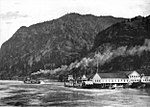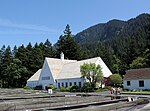John B. Yeon State Scenic Corridor
Multnomah County, Oregon geography stubsParks in Multnomah County, OregonState parks of OregonUse mdy dates from August 2023

John B. Yeon State Scenic Corridor is a state park in the U.S. state of Oregon, administered by the Oregon Parks and Recreation Department. It is located about 35 miles east of Portland in the Columbia Gorge. It is named in honor of John B. Yeon, one of the principal financiers of the Historic Columbia River Highway U.S. Route 30 which was constructed between 1913 and 1922. Located in the Columbia River Gorge National Scenic Area, the park features hiking trails that access some of the nearby waterfalls, including Elowah Falls.
Excerpt from the Wikipedia article John B. Yeon State Scenic Corridor (License: CC BY-SA 3.0, Authors, Images).John B. Yeon State Scenic Corridor
Columbia River Highway,
Geographical coordinates (GPS) Address Nearby Places Show on map
Geographical coordinates (GPS)
| Latitude | Longitude |
|---|---|
| N 45.6195617 ° | E -121.9867493 ° |
Address
Columbia River Highway (Vietnam Veterans Memorial Highway)
Columbia River Highway
97014
Oregon, United States
Open on Google Maps






